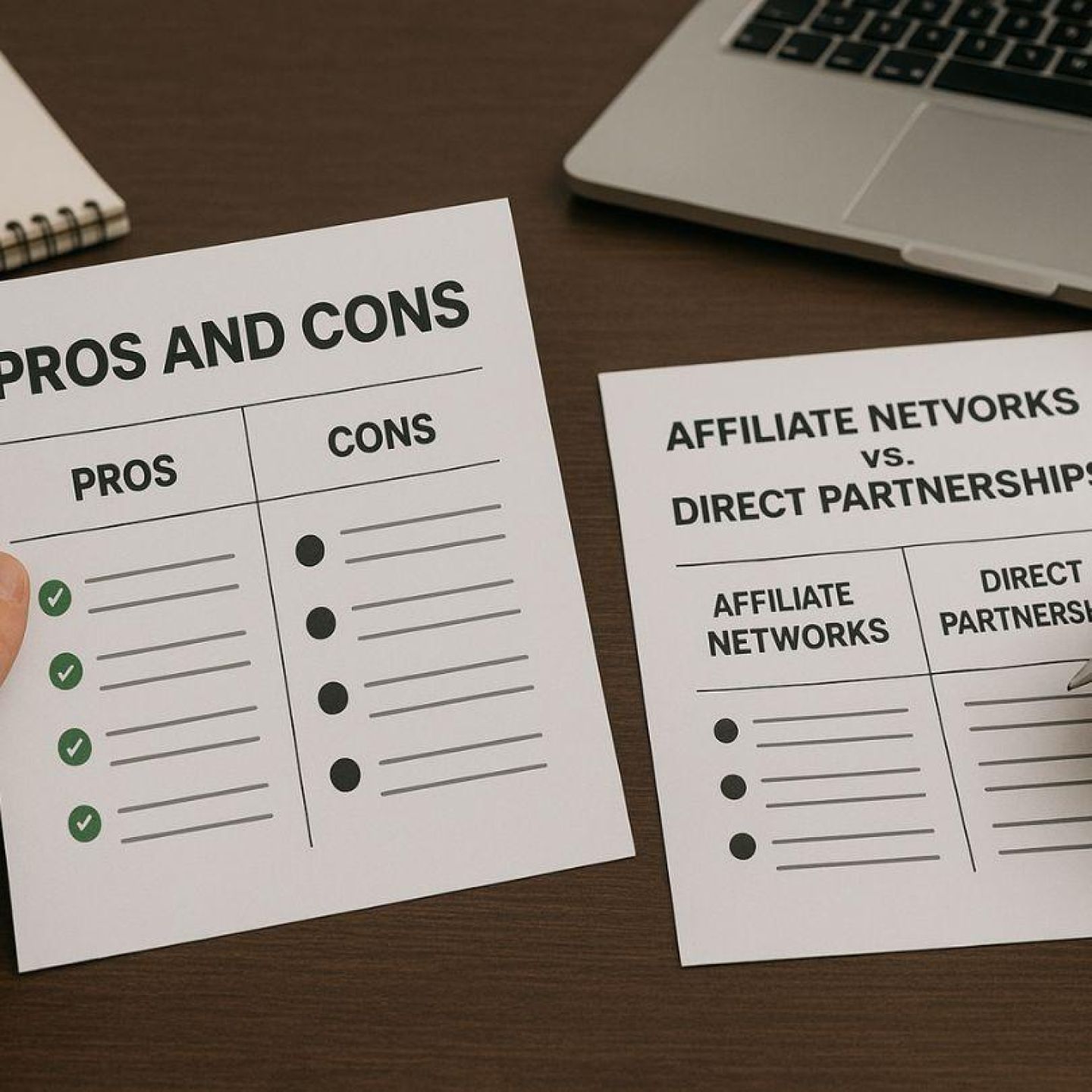
Our tools monitor millions of native, push, pop, and TikTok advertising campaigns.
Get StartedAffiliate marketing has become a cornerstone of digital commerce, generating billions in revenue annually. This performance-based marketing strategy allows businesses to expand their reach through partnerships with content creators, influencers, and marketers who promote products in exchange for commissions.
The success of your affiliate program depends heavily on choosing the right management approach. You face two primary affiliate marketing models: working through established affiliate networks or building direct partnerships with individual affiliates. Each path offers distinct advantages and challenges that can significantly impact your program's performance and profitability.
Affiliate networks vs direct partnerships represents one of the most critical decisions you'll make when launching or scaling your affiliate program. Networks like Amazon Associates and Commission Junction provide ready-made infrastructure and vast affiliate pools, while direct partnerships offer greater control and potentially higher profit margins.
This comprehensive partnership comparison will examine the pros and cons of both approaches, helping you determine which model aligns best with your business goals, resources, and target market. The right choice can mean the difference between a thriving affiliate program and missed opportunities.
It's also worth considering the differences between affiliate marketing and sponsorships, as both can be effective strategies depending on your specific needs and objectives.
Affiliate networks are platforms that connect merchants looking for partners to promote their products with affiliates who want to find products to promote. These networks create a marketplace where businesses can showcase their affiliate programs and publishers can browse opportunities that match their audience and expertise.
Affiliate networks do more than just connect merchants and affiliates. They offer automated systems for managing affiliates that take care of the technical aspects of running successful affiliate programs. By joining established networks like Commission Junction or Amazon Associates, you can access a powerful infrastructure that makes your affiliate marketing operations smoother.
Modern affiliate networks offer several important features:
These platforms usually charge a fee based on a percentage of sales for their services. This fee covers the technology infrastructure, customer support, and ongoing maintenance of the platform. The fee structure varies between networks, with some charging merchants while others collect fees from affiliates or use a combination of both.
Networks like Cpamatica have built their reputation on providing merchants with access to thousands of pre-vetted affiliates across different industries. This allows them to quickly scale their programs without having to individually recruit and manage each affiliate.
Direct affiliate partnerships represent a fundamentally different approach to affiliate marketing, where businesses establish one-on-one relationships with individual affiliates without any intermediary platform. You work directly with each affiliate, creating customized agreements that serve both parties' specific needs and objectives.
This model puts you in the driver's seat of your affiliate program. You handle every aspect of the relationship - from initial outreach and recruitment to ongoing communication and performance monitoring. Hands-on management becomes your primary tool for building meaningful connections with affiliates who genuinely understand and align with your brand values.
The control you gain extends to every promotional strategy. You decide which marketing channels each affiliate can use, approve their promotional content, and set specific guidelines for how they represent your brand. This level of oversight allows you to maintain brand consistency while leveraging each affiliate's unique strengths.
Personalized affiliate relationships flourish in this environment because you invest time in understanding each partner's audience, marketing style, and business goals. You can offer specialized training, exclusive product access, or custom landing pages that maximize conversion rates for their specific traffic sources.
The advantages of affiliate networks make them an attractive option for businesses looking to scale their affiliate marketing efforts efficiently. These platforms serve as powerful intermediaries that can transform your marketing reach and operational efficiency.
Understanding these pros and cons will help you decide whether an affiliate network is right for your business.
While affiliate networks provide significant advantages, the disadvantages of affiliate networks can impact your business operations and profitability in meaningful ways.
Affiliate networks create a barrier between you and your affiliates. You communicate through the network's platform rather than establishing direct relationships with the people promoting your products. This intermediary structure limits your ability to:
The network essentially becomes the middleman in all communications, which can slow down decision-making and reduce the personal touch that often drives affiliate loyalty.
Network fees represent one of the most significant drawbacks of using affiliate networks. These platforms typically charge between 10-30% of your affiliate commissions as their service fee. If you're paying affiliates a 10% commission, you might actually pay 13-15% total when including network fees.
Consider this example: You generate $10,000 in affiliate sales with a 10% commission structure. You'll pay $1,000 to affiliates plus an additional $200-300 in network fees, reducing your profit margins substantially.
Most affiliate networks operate with standardized systems that offer limited customization. You're often restricted to:
This standardization prevents you from creating unique incentive programs or tailoring your approach to specific affiliate segments that might require different treatment or compensation models.
Direct partnerships represent a fundamentally different approach to affiliate marketing, where you establish one-on-one relationships with individual affiliates without any intermediary platform. This model puts you in the driver's seat of your affiliate program, offering distinct advantages that many businesses find compelling.
You handpick every affiliate who represents your brand. This selective process allows you to align with partners who genuinely understand your products and share your brand values. You can evaluate their audience quality, content style, and promotional methods before bringing them aboard.
Direct communication eliminates the middleman barrier. You can reach your affiliates instantly through email, phone calls, or messaging platforms. This immediate access enables real-time campaign adjustments, quick problem resolution, and stronger relationship building.
Network fees typically range from 15-30% of affiliate commissions. By eliminating these costs, you can offer more competitive commission rates to your affiliates while maintaining your profit margins. This financial advantage often attracts high-performing affiliates who might otherwise work with competitors.
You can create customized promotional materials, exclusive offers, and tailored campaigns for specific affiliates. This personalized marketing approach allows you to leverage each affiliate's unique strengths and audience characteristics for maximum impact.
Direct oversight means you can monitor how affiliates represent your brand more closely. You set the promotional guidelines, approve marketing materials, and ensure consistent brand messaging across all affiliate activities.
While direct partnerships offer compelling advantages, the drawbacks direct partnerships present can significantly impact your business operations. You'll quickly discover that managing individual affiliate relationships demands substantial time investment and resources.
The management overheads associated with direct partnerships extend far beyond initial setup. You must handle recruitment, onboarding, contract negotiations, and ongoing communication with each affiliate individually. This means dedicating hours to:
Each affiliate relationship requires personalized attention, making scalability a genuine challenge as your program grows.
The limited reach affiliates problem becomes apparent when comparing your partner pool to network alternatives. You're essentially building from scratch, which means:
Your promotional reach remains constrained by the number of quality affiliates you can personally recruit and maintain relationships with.
Direct partnerships demand dedicated staff or significant time from existing team members. You need tracking software, payment systems, and administrative processes that networks typically provide as standard features. These operational requirements can strain smaller businesses or those without dedicated affiliate management teams.
The question Affiliate Networks vs Direct Partnerships: Which Wins? becomes particularly relevant when considering these operational realities against your available resources.
Selecting affiliate model based on business goals requires careful evaluation of your company's resources, target market, and growth objectives. Your decision should align with your operational capacity and marketing strategy.
Affiliate networks excel when you need mass-market exposure with minimal administrative burden. E-commerce businesses selling consumer products, SaaS companies targeting broad audiences, or startups with limited marketing teams benefit from network automation. The built-in infrastructure handles recruitment, tracking, and payments while you focus on core business operations.
Consider networks if you:
Direct partnerships shine for businesses requiring targeted engagement and personalized relationships. Companies selling high-ticket items, B2B services, or specialized products often achieve better results through direct collaboration. You can craft customized commission structures and provide detailed product training to select affiliates.
Choosing the right model favors direct partnerships when you:
Your business size, product complexity, and available resources determine which approach delivers optimal results for your affiliate marketing objectives.
A hybrid strategy in affiliate marketing allows you to capture the benefits of both models while minimizing their individual drawbacks. This approach starts with affiliate networks to establish your program's foundation, then strategically transitions your best performers into direct partnerships.
The process begins by launching your affiliate program through established networks like Commission Junction or ShareASale. You gain immediate access to thousands of potential affiliates without the overhead of individual recruitment. The network's tracking systems and automated payments handle the operational complexity while you identify which affiliates generate the highest quality traffic and conversions.
After 3-6 months of performance data, you can approach your top 10-20% of affiliates with direct partnership offers. These high-performers typically appreciate:
You maintain your network presence for continuous affiliate recruitment while nurturing these premium direct relationships. This dual approach provides the scalability of networks with the control and profitability of direct partnerships.
The key lies in using performance metrics from your network dashboard to identify affiliates who demonstrate consistent sales volume, quality traffic, and brand alignment before making the transition offer.
Clear communication serves as the foundation for optimizing affiliate programs for success in both network and direct partnership models. You need to establish transparent commission structures that leave no room for confusion about payment terms, performance metrics, and payout schedules. When affiliates understand exactly how they earn and when they get paid, they invest more effort into promoting your products effectively.
Data analytics becomes your most powerful weapon for maximizing affiliate success. In affiliate networks, you can leverage built-in reporting tools to identify top-performing affiliates, analyze conversion patterns, and spot underperforming campaigns. Platforms like Commission Junction and Amazon Associates provide detailed dashboards showing click-through rates, conversion percentages, and revenue attribution.
For direct partnerships, you'll need to implement robust tracking systems like Post Affiliate Pro or PartnerStack to gather similar insights. The key lies in regularly reviewing performance data to:
When debating Affiliate Networks vs Direct Partnerships: Which Wins?, remember that success depends more on your execution than your chosen model. Regular performance reviews, prompt communication, and data-driven optimization strategies will drive results regardless of whether you work through networks or direct relationships.
Affiliate Networks vs Direct Partnerships: Which Wins? The answer depends entirely on your business objectives and available resources. Each model presents distinct advantages that align with different marketing strategies.
Your choice should reflect your company's current position and growth aspirations. Consider these critical factors when making your decision:
The summary pros cons affiliate models reveals that networks excel in scalability and automation, while direct partnerships shine in customization and relationship depth. You might discover that your business benefits from starting with one approach and evolving toward another as your program matures.
Success in affiliate marketing isn't determined by the model you choose—it's built through strategic planning, consistent execution, and continuous optimization. Take time to evaluate your specific needs, test different approaches, and remain flexible as your affiliate program grows.
Receive top converting landing pages in your inbox every week from us.
Tips & Tricks
Year-end is the perfect time to refine your affiliate marketing approach and boost conversions. Learn five proven strategies to optimize campaigns, enhance ad performance, and take advantage of seasonal buyer intent. Discover actionable tips to maximize revenue and end the year on a high note. Perfect for affiliates ready to turn Q4 momentum into measurable success.
David Kim
7 minNov 25, 2025
Tips & Tricks
This blog shares proven strategies to help affiliates increase their sales before the year ends. It covers actionable tips on optimizing campaigns, leveraging seasonal trends, and refining ad creatives for higher conversions. Readers will discover how to make the most of Q4 opportunities and finish the year strong. Perfect for affiliate marketers aiming to maximize profits during the busiest shopping season.
Priya Kapoor
7 minNov 22, 2025
Announcement
This blog explores the emerging trend of affiliate partnerships with major streaming platforms and how they’re reshaping digital marketing. It explains how brands and affiliates can collaborate to tap into engaged audiences through sponsored content and integrated promotions. Readers will learn about partnership models, monetization opportunities, and key strategies for success in this growing space. Perfect for marketers eager to stay ahead in the evolving world of affiliate marketing.
Samantha Reed
7 minNov 20, 2025




